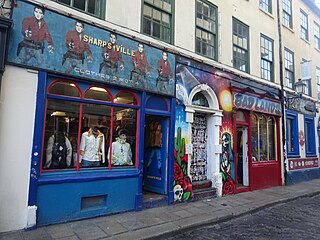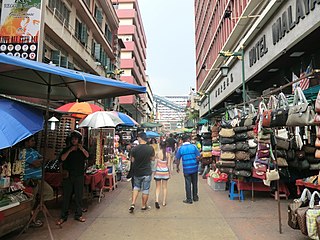Related Research Articles

Fashion is a term used interchangeably to describe the creation of clothing, footwear, accessories, cosmetics, and jewellery of different cultural aesthetics and their mix and match into outfits that depict distinctive ways of dressing as signifiers of social status, self-expression, and group belonging. As a multifaceted term, fashion describes an industry, styles, aesthetics, and trends.

Industria de Diseño Textil, S.A. is a Spanish multinational clothing company headquartered in Arteixo, Galicia, Spain. Inditex, the biggest fast fashion group in the world, operates over 7,200 stores in 93 markets worldwide. The company's flagship brand is Zara, but it also owns a number of other brands such as Zara Home, Bershka, Massimo Dutti, Oysho, Pull&Bear, Stradivarius, Uterqüe and Lefties. The majority of its stores are corporate-owned, while franchises are mainly conceded in countries where corporate properties cannot be foreign-owned.

In economics, a luxury good is a good for which demand increases more than what is proportional as income rises, so that expenditures on the good become a more significant proportion of overall spending. Luxury goods are in contrast to necessity goods, where demand increases proportionally less than income. Luxury goods is often used synonymously with superior goods.

Zara is a Spanish multinational fast-fashion company. It sells clothing, accessories, beauty products and perfumes. The head office is located at Arteixo in the province of A Coruña, Galicia. It is the largest constituent company of the Inditex group. In 2020, it was launching over twenty new product lines per year.
Streetwear is a style of casual clothing which became global in the 1990s. It grew from New York hip hop fashion and Californian surf culture to encompass elements of sportswear, punk, skateboarding, 1980s nostalgia, and Japanese street fashion. Later, haute couture became an influence, and was in turn influenced by streetwear. Streetwear centers on comfortable clothing and accessories such as jeans, T-shirts, baseball caps, and sneakers. Brands may create exclusivity through intentional product scarcity; enthusiasts follow particular brands and try to obtain limited edition releases, including via proxy purchases.

Vintage clothing is a generic term for garments originating from a previous era, as recent as the 1990s. The term can also be applied in reference to second-hand retail outlets, e.g. in vintage clothing store. While the concept originated during World War I as a response to textile shortages, vintage dressing encompasses choosing accessories, mixing vintage garments with new, as well as creating an ensemble of various styles and periods. Vintage clothes typically sell at low prices for high-end name brands.
A lifestyle brand is a brand that attempts to embody the values, aspirations, interests, attitudes, or opinions of a group or a culture for marketing purposes. Lifestyle brands seek to inspire, guide, and motivate people, with the goal of making their products contribute to the definition of the consumer's way of life. As such, they are closely associated with the advertising and other promotions used to gain mind share in their target market. They often operate from an ideology, hoping to attract a relatively high number of people and ultimately become a recognised social phenomenon.

Fast fashion is the business model of replicating recent catwalk trends and high-fashion designs, mass-producing them at a low cost, and bringing them to retail quickly while demand is at its highest. The term fast fashion is also used generically to describe the products of this business model, particularly clothing and footwear. Retailers who employ the fast fashion strategy include Primark, H&M, Shein, and Zara, all of which have become large multinationals by driving high turnover of inexpensive seasonal and trendy clothing that appeals to fashion-conscious consumers.

The term designer label refers to clothing, luxury automobile manufacturers and other personal accessory items sold under an often prestigious marque which is commonly named after a designer, founder, or a location-like where the company was founded. The term is most often applied to luxury goods. While members of the upper middle class, or the mass affluent, are perhaps the most commonly targeted customers of these designer labels, some marquees—such as Cartier, Rolex, Montblanc and the haute couture — tend to a wealthier customer base. But almost every designer brand has merchandise that the middle-class wouldn't normally be able to afford, such as exotic skins, furs and hides, limited edition pieces, or things simply priced higher. Designer label companies use their smaller and cheaper merchandise, aimed at the middle class, such as wallets, fashion jewellery, key-rings and small accessories, to make the majority of their income, whilst the more expensive pieces such as haute couture, high jewellery, hand-bags, shoes and even furnishings are usually reserved for the wealthier upper-class clientele.

Fashion design is the art of applying design, aesthetics, clothing construction and natural beauty to clothing and its accessories. It is influenced by culture and different trends, and has varied over time and place. "A fashion designer creates clothing, including dresses, suits, pants, and skirts, and accessories like shoes and handbags, for consumers. He or she can specialize in clothing, accessory, or jewelry design, or may work in more than one of these areas."

Sustainable fashion is a term describing efforts within the fashion industry to reduce its environmental impacts, protect workers producing garments, and uphold animal welfare. Sustainability in fashion encompasses a wide range of factors, including cutting CO2 emissions, addressing overproduction, reducing pollution and waste, supporting biodiversity, and ensuring that garment workers are paid a fair wage and have safe working conditions.
Fashion forecasting began in France during the reign of Louis XIV. It started as a way of communicating about fashion and slowly transformed into a way to become ahead of the times in the fashion industry. Fashion forecasting predicts the moods of society and consumers, along with their behavior and buying habits and bases what they may release in the coming future off of the forecast. Fashion trends tend to repeat themselves every 20 years, and fashion forecasting predicts what other trends might begin with the rotation of fashion as well. Fashion forecasting can be used for many different reasons, the main reason being staying on top of current trends and knowing what your consumer is going to want in the future. This method helps fashion brands know what to expect and what to begin producing ahead of time. Top name brands and high end companies such as Vogue and Gucci even use this method to help their designers become even more informed on what is to come in the fashion industry.
Wholesale fashion distribution refers to the global market of bulk clothing sales, in which producers, wholesalers and sellers are involved in a commercial, business-to-business process.
'Fast fit' refers to a method of handling the shipping and sampling processes typical of multinational organizations who primarily manufacture offshore, specifically in the fashion and textile industry. The Fast Fit philosophy centers on the sharing of 360-degree, annotatable images intended to reduce the costs and lead times associated with shipping physical samples. The term is particularly prevalent among companies that fit the Fast Fashion model, as Fast Fit is considered to be a vital component in the reduction of time between design inspiration and final production of a garment or product.

Clothing industry or garment industry summarizes the types of trade and industry along the production and value chain of clothing and garments, starting with the textile industry, embellishment using embroidery, via the fashion industry to apparel retailers up to trade with second-hand clothes and textile recycling. The producing sectors build upon a wealth of clothing technology some of which, like the loom, the cotton gin, and the sewing machine heralded industrialization not only of the previous textile manufacturing practices. Clothing industries are also known as allied industries, fashion industries, garment industries, or soft goods industries.

Digital Fashion is the visual representation of clothing built using computer technologies and 3D software. This industry is on the rise due to ethical awareness and uses of digital fashion technology such as artificial intelligence to create products with complex social and technical software.

Fashion tourism is a niche market segment evolved out of three major sectors: Creative Tourism, Cultural Tourism and Shopping Tourism. Fashion Tourism can be defined as “the interaction between Destination Marketing Organizations (DMOs), trade associations, tourism suppliers and host communities, with people travelling to and visiting a particular place for business or leisure to enjoy, experiment, discover, study, trade, communicate about and consume fashion.”

Slow fashion is an aspect of sustainable fashion and a concept describing the opposite to fast fashion, part of the "slow movement" advocating for clothing and apparel manufacturing in respect to people, environment and animals. As such, contrary to the industrial practices of fast fashion conglomerates, slow fashion involves local artisans and the use of eco-friendly materials, with the goal of preserving crafts and the environment which, ultimately, provides value to all, slow fashion brands, consumers and retailers.
Hype in marketing is a strategy of using extreme publicity. Hype as a modern marketing strategy is closely associated with social media.

Fast fashion is a term used to represent cheap, trendy clothing that is made to replicate higher end fashion trends. As of 2019, China remains the leading producer of fast fashion clothing. Many sweatshops are located in China, where the workers are underpaid and overworked in unsafe environments. China produces 65% of the world's clothing, with a majority of these clothes being labeled as "fast fashion". The top ten competitors in the fast fashion market make up 29.13% of the whole fashion market in 2020.
References
- 1 2 3 4 5 "Fashion Brand". www.brand-trust.de. Retrieved 2023-05-13.
- 1 2 "What is Fashion Brand | IGI Global". www.igi-global.com. Retrieved 2023-05-13.
- 1 2 "Top15 Best Fashion Companies In India 2023 - Inventiva". 2023-03-07. Retrieved 2023-05-14.
- ↑ "Understanding the Influence of Brand Personality on Consumer Behavior - Volume 3, No. 1, March, 2015 - Journal of Advanced Management Science (JOAMS)". www.joams.com. Retrieved 2023-05-14.
- 1 2 3 4 5 Huggard, Emily; Cope, Jon (2020-02-19). Communicating Fashion Brands: Theoretical and Practical Perspectives. Routledge. ISBN 978-0-429-87558-8.
- ↑ Tungate, Mark (2005). Fashion Brands: Branding Style from Armani to Zara. Kogan Page Publishers. ISBN 978-0-7494-4299-6.
- 1 2 3 "Fashion industry | Design, Fashion Shows, Marketing, & Facts | Britannica". www.britannica.com. Retrieved 2023-05-14.
- ↑ "What Does Couture Mean- Definition and French Translation - The Dapifer". 2017-07-08. Archived from the original on 2017-07-08. Retrieved 2023-05-14.
- 1 2 3 Jin, Byoungho; Cedrola, Elena (2016-06-28). Fashion Brand Internationalization: Opportunities and Challenges. Springer. p. 2. ISBN 978-1-137-52337-2.
- ↑ Bouchet, Patrick; Hillairet, Dieter; Bodet, Guillaume (2013). Sport Brands. Routledge. p. 136. ISBN 978-0-415-53284-6.
- ↑ "Luxury Brands, Premium Brands". www.brand-trust.de. Retrieved 2023-05-13.
- ↑ Fionda, Antoinette M; Moore, Christopher M (March 2009). "The anatomy of the luxury fashion brand". Journal of Brand Management. 16 (5–6): 347–363. doi:10.1057/bm.2008.45. ISSN 1350-231X. S2CID 167898713.
- 1 2 Beras, Erika (2018-08-01). "Mid-luxury brands say no to discounted goods". Marketplace. Retrieved 2023-05-13.
- ↑ Bhardwaj, Vertica; Fairhurst, Ann (February 2010). "Fast fashion: response to changes in the fashion industry". The International Review of Retail, Distribution and Consumer Research. 20 (1): 165–173. doi:10.1080/09593960903498300. ISSN 0959-3969. S2CID 167708658.
- ↑ Sull, Donald; Turconi, Stefano (June 2008). "Fast fashion lessons". Business Strategy Review. 19 (2): 4–11. doi:10.1111/j.1467-8616.2008.00527.x. ISSN 0955-6419. S2CID 154671050.